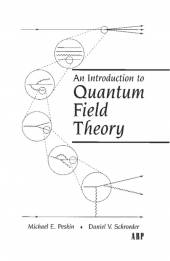Peskin, Schroeder: An Introduction to Quantum Field Theory
Why is it interesting?

Peskin and Schroeder's "An Introduction to Quantum Field Theory" is the quantum field theory standard textbook.
, For over a decade this has been the standard in QFT pedagogy. It has everything a student could want presented coherently. The style is geared towards calculations, which makes it a handy reference. […] Every QFT student needs this book… but absolute beginners may not find this the most user-friendly text and would benefit from additional references. Either way, I would suggest basing one’s study on Peskin with well-selected auxilliary reading.Flip Tanedo
Reading Notes/Summaries
- Chapter 2:
-
2.1 The necessity of the field viewpoint
The obvious generalisation from QM of trying to quantize relativistic particles fails due to non-conservation of particle number (deemed necessary by Schrodinger’s equation and impossible by special relativity). Also, the amplitude of propagation between spacelike separated points is non-zero in ordinary QM, even with a relativistic Hamiltonian. An exact cancellation is required for maintaining causality, and QFT provides a natural way of doing so - by creating antiparticles.
2.2 Elements of classical field theory
The principle of least action implies the Euler-Lagrange equation of motion - they are classical paths living in configuration space. In analogy with QM, we can define the canonical (conjugate) momentum used to switch to the Hamiltonian formalism. However, H isn’t inherently Lorentz invariant, unlike L, which is. The Noether’s theorem states that every continuous symmetry leads to a conserved local current (and hence globally conserved charges). U(1) symmetry in the complex Klein-Gordon Lagrangian is interpreted (upon coupling to E-mag field) as a conserved electric current, Lorentz symmetry leads to (4 conserved currents, put together as) a conserved stress-energy tensor, etc. The Hamiltonian naturally arises as a conserved charge from time-translation symmetry inscribed in the latter.
2.3 The Klein-Gordon field as harmonic oscillators
To quantise a classical theory, we promote the dynamical variables to operators and write down their commutation relations. φ and π are dynamical variables in field theory, and we write down their commutation relations in the Schrödinger picture (or equal time CR in Heisenberg). For the (energy) spectrum of H for KGE, we expand φ and π in Fourier modes (where w